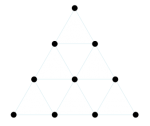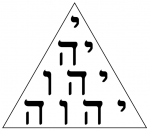Tetraktys: Difference between revisions
Pablo Sender (talk | contribs) |
Pablo Sender (talk | contribs) |
||
| Line 7: | Line 7: | ||
[[File:Tetraktys Tetragrammaton.png|150px|right]] | [[File:Tetraktys Tetragrammaton.png|150px|right]] | ||
There is an arrangement of the letters of the [[Tetragrammaton]] (the four lettered name of God in Hebrew scripture יהוה or YHWH), where they are inscribed on the ten positions of the tetraktys, from right to left. | There is an arrangement of the letters of the [[Tetragrammaton]] (the four lettered name of God in Hebrew scripture יהוה or YHWH), where they are inscribed on the ten positions of the tetraktys, from right to left. | ||
In this regard, Mme. Blavatsky said: | |||
<blockquote>The Tetrad is esteemed in the Kabala, as it was by Pythagoras, the most perfect, or rather sacred number, because it emanated from the one, the first manifested Unit, or rather the three in one. Yet the latter has been ever impersonal, sexless, incomprehensible, though within the possibility of the higher mental perceptions.<ref>Helena Petrovna Blavatsky, ''The Secret Doctrine'' vol. II, (Wheaton, IL: Theosophical Publishing House, 1993), 599.</ref></blockquote> | |||
Revision as of 16:03, 22 August 2012
Tetraktys (τετρακτύς) is a Greek word meaning "tetrad". It refers to a triangular figure consisting of ten points arranged in four levels with one, two, three, and four points in each row. This was an important mystical symbol used by the Pythagoreans.
In Theosophy
In Kabbalah
There is an arrangement of the letters of the Tetragrammaton (the four lettered name of God in Hebrew scripture יהוה or YHWH), where they are inscribed on the ten positions of the tetraktys, from right to left.
In this regard, Mme. Blavatsky said:
The Tetrad is esteemed in the Kabala, as it was by Pythagoras, the most perfect, or rather sacred number, because it emanated from the one, the first manifested Unit, or rather the three in one. Yet the latter has been ever impersonal, sexless, incomprehensible, though within the possibility of the higher mental perceptions.[1]
- ↑ Helena Petrovna Blavatsky, The Secret Doctrine vol. II, (Wheaton, IL: Theosophical Publishing House, 1993), 599.

